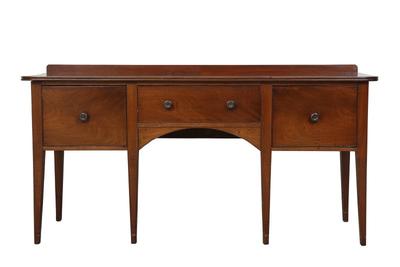Sideboard
Maker & role
Unknown, Maker
Production date
circa 1820
See full details
Object detail
Production place
Collection
Measurements
0 - Whole, H: 97.7 x W: 194 x D: 61.5cm (H: 977 x W: 1940 x D: 615mm); carcass, H: 92.5 x W: 182 x D: 53cm (H: 925 x W: 1820 x D: 530mm)
Signature & marks
Typed label adhered to verso (probably authored by Mrs Elizabeth Rothe, who gave the sideboard to the HHT): ‘This sideboard was made from local cedar for John Macarthur. It was part of the furnishing in the cottage on the Camden estate where he spent much of his time while the Mansion House was being built. After John Macarthur’s death in 1874 [recte 1834] and the completion of the Mansion House in the same year, the estate office was established at the Mansion House and it was used there as an office desk. The desk was left at the Mansion House when the Estate Office was moved to John Macarthur’s cottage at the Home Farm in 1932. It was restored and given by General J. W. Macarthur Onslow to his daughter Elizabeth, in 1935.’
Credit line
Bequest, 1993
Elizabeth Farm Collection, Museums of History New South Wales
Elizabeth Farm Collection, Museums of History New South Wales
Caption
Sideboard from Belgenny Farm, c1820
Description
The appeal of this exceedingly chaste sideboard is found in its proportions, the subtle definition of its parts and its excellent cuts of cedar whose grain ripples across the surface of the piece. The rounded slab top is made to appear more slender by a double beaded edge. The Georgian love of slender mouldings is carried through to the three drawers and central arch being emphasised discretely by cock beading (applied strips that protrude slightly past the sides of the drawers) and the well placed reeded knobs. The piece stands on six square tapered legs and harks back to the designs of Hepplewhite (1787) and Sheraton (1802) rather than the more current Greek Revival, which John Macarthur (1767-1834) was to embrace in his remodelling of Elizabeth Farm, Parramatta, in 1826 and the building of Camden Park to the designs of John Verge in 1831-34.
By Macarthur family tradition the sideboard was made for the house that was to become the nucleus of 'Belgenny', the Camden Park home farm. The original slab hut was replaced in 1821 by a cottage orné, or picturesque gentleman’s cottage by the young architect, Henry Kitchen, no doubt with considerable input from John Macarthur, ever the amateur architect. The lack of pretension of this piece is probably related to its 'retired', country setting and its likely manufacture by one of Macarthur’s joiners. Macarthur was to build four cottages ornés and the quality of their joinery gives them much of their sophistication. Macarthur is known to have owned a campaign dining table c1805, probably by the firm of Butler or by Morgan & Sanders. The demountable quality of the dining table suited flexible room use and relatively light-weight furniture such as this sideboard.
'The sideboard was removed to Camden Park, the Mansion House and it was used there as an office desk. The desk was left at the Mansion House when the Estate Office was moved to John Macarthur’s cottage (unfortunately rebuilt) at the Home Farm in 1932. It was restored and given by General J. W. Macarthur Onslow to his daughter Elizabeth, in 1935'*.
Mrs Elizabeth Rothe allowed the copying of the sideboard by the Historic Houses Trust of New South Wales (now MHNSW) for Elizabeth Farm in 1984 as part of a policy of presenting the interiors with replica Macarthur furniture and she made a bequest of the sideboard on her death in 1993.
* label by Mrs Elizabeth Rothe attached to the back of the piece
By Macarthur family tradition the sideboard was made for the house that was to become the nucleus of 'Belgenny', the Camden Park home farm. The original slab hut was replaced in 1821 by a cottage orné, or picturesque gentleman’s cottage by the young architect, Henry Kitchen, no doubt with considerable input from John Macarthur, ever the amateur architect. The lack of pretension of this piece is probably related to its 'retired', country setting and its likely manufacture by one of Macarthur’s joiners. Macarthur was to build four cottages ornés and the quality of their joinery gives them much of their sophistication. Macarthur is known to have owned a campaign dining table c1805, probably by the firm of Butler or by Morgan & Sanders. The demountable quality of the dining table suited flexible room use and relatively light-weight furniture such as this sideboard.
'The sideboard was removed to Camden Park, the Mansion House and it was used there as an office desk. The desk was left at the Mansion House when the Estate Office was moved to John Macarthur’s cottage (unfortunately rebuilt) at the Home Farm in 1932. It was restored and given by General J. W. Macarthur Onslow to his daughter Elizabeth, in 1935'*.
Mrs Elizabeth Rothe allowed the copying of the sideboard by the Historic Houses Trust of New South Wales (now MHNSW) for Elizabeth Farm in 1984 as part of a policy of presenting the interiors with replica Macarthur furniture and she made a bequest of the sideboard on her death in 1993.
* label by Mrs Elizabeth Rothe attached to the back of the piece
Accession number
EF94/2



Public comments
Be the first to comment on this object record.